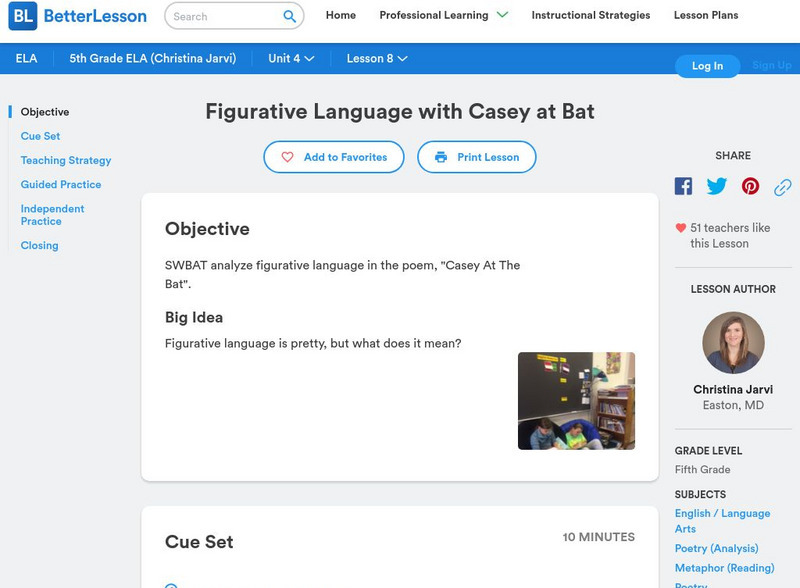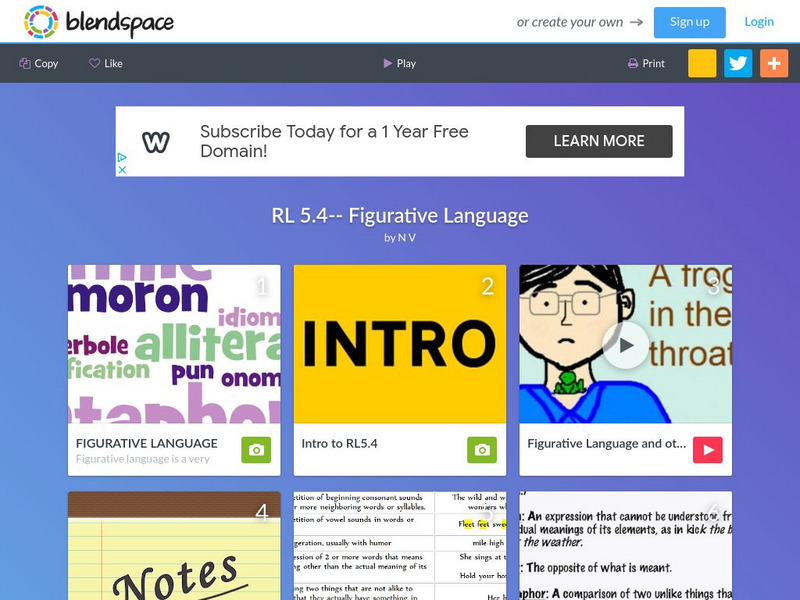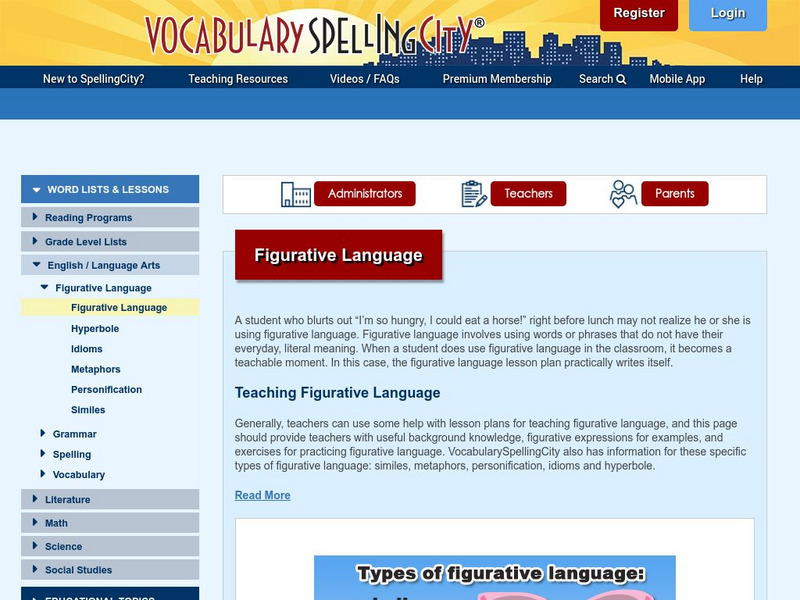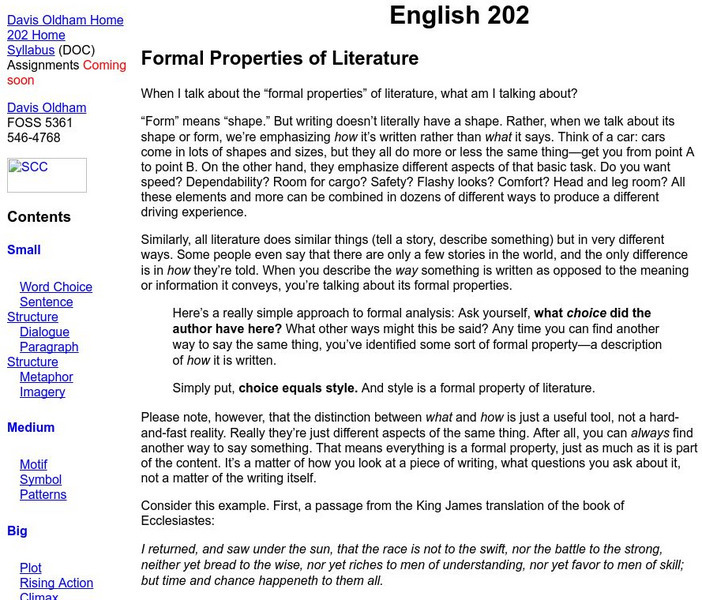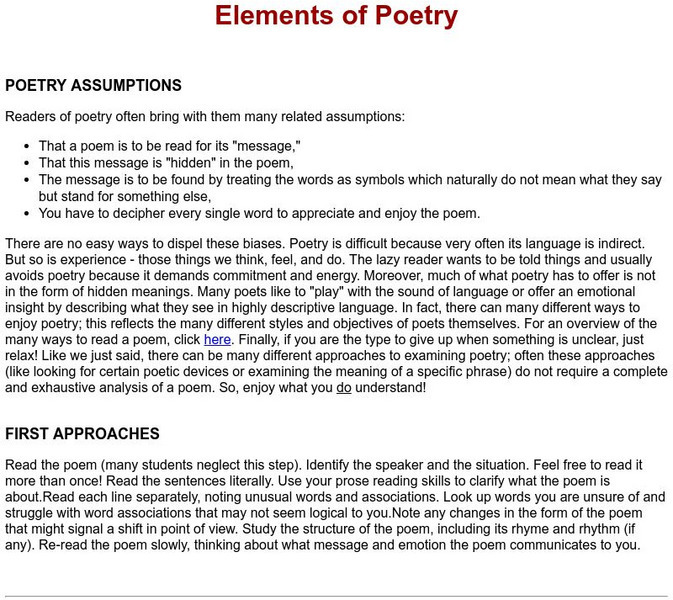Texas Education Agency
Texas Gateway: Imagery and Figurative Language (Grade 6)
This lesson focuses on the use of imagery and figurative language in writing to aid understanding and create images in the mind.
Better Lesson
Better Lesson: Go Figure With Figurative Language It Helps With Predicting!
In this lesson plan, students will use figurative language, digital tools, and illustrations to write a story. The teacher will model how to use an app that has onomatopoeia to create a story with a good beginning, middle, and end. A...
E Reading Worksheets
E Reading Worksheets: Figurative Language Worksheets
This learning module provides remediation and extra practice with identifying different types of figurative language. Reinforcement is provided through the worksheets, quizzes, video game links, and online sites for the following types...
Better Lesson
Better Lesson: Unit: Figurative Language With Casey at Bat
In this lesson, 5th graders learn how to analyze figurative language in the poem, "Casey At The Bat."
TES Global
Blendspace: Rl 5.4 Figurative Language
This twelve-part learning module provides assorted references for figurative language terms. This blendspace provides reproducible charts, flash cards, a game, video tutorial lessons, and rap songs. L.9-10.5 Fig Lang/nuances
Alabama Learning Exchange
Alex: Plath, Personification, and Figurative Language
This project based activity will use Sylvia Plath's poem, "Mirror", to examine the use of personification and figurative language. The activity may also incorporate the use of technology to produce a multimedia project. This allows...
Vocabulary Spelling City
Spelling City: Figurative Language
This website focuses on figurative language: hyperbole, simile, metaphor, personification, and idioms. It provides lists of examples for each based on three educational levels: elementary, middle school, and high school.
Read Works
Read Works: Fourth Grade: Three Lesson Unit: Figurative Language
[Free Registration/Login Required] A lesson plan, based on In a Pickle and Other Funny Idioms by Marvin Terba, in which learners learn how understand idioms and use them to explain the plot and to make predictions. With free login, users...
Khan Academy
Khan Academy: The Sound of Language
Can you spot writers' use of alliteration, assonance, and onomatopoeia that add sound effects to their language?
Other
Fu Jen Univ.: Poetic Elements: Denotation and Connotation: Figures of Speech
This site gives short definitions of the terms denotation and connotation. Also gives definitions for many figures of speech. Finally, includes discussion and study questions for a few poems at the bottom of the page. L.11-12.5b Nuance
Folger Shakespeare Library
Folger Shakespeare Library: Lesson Plan Archive: Imagery in Hamlet
Lesson plan takes students through an exploration of the figurative language in "Hamlet."
E Reading Worksheets
E Reading Worksheets: Lord of the Flies
In this learning module, students will engage in a deep study of William Golding's novel, Lord of the Flies. A game to reinforce the understanding of the conficts in the Lord of the Flies is available. Worksheets with figurative devices...
PBS
Wnet: Thirteen: I Have a Metaphor
This lesson not only examines the message of Dr. King, but also the words themselves. This is a lesson in identifying the literary devices that he used in his "I Have a Dream" Speech. It will introduce the following literary devices:...
Alabama Learning Exchange
Alex: Poetry and Music Fun With Chris Daughtry
This language arts lesson grabs students' attention by incorporating a popular musician. The lyrics to "Over You" include vivid language that makes identifying figures of speech intriguing. The students will identify similes, metaphors,...
Other
Shoreline Community College: Formal Properties of Literature
As students become more aware of text complexity, an understanding of the formal properties of literature becomes more important. This is an excellent examination of the kinds of choices writers make that change the way readers receive...
Alabama Learning Exchange
Alex: What Are Idioms?
After listening to More Parts by Tedd Arnold read aloud, intermediate school students distinguish between literal and figurative meaning by using a graphic organizer, playing an online game, and incorporating an idiom into their writing.
Read Works
Read Works: 4th Grade Lesson: Similes and Metaphors
[Free Registration/Login Required] A lesson in which students use the book Poetry for Young People: Langston Hughes edited by David Roessel and Arnold Rampersad to learn to identify and understand the use of simile and metaphor in...
Other
E Tutor, Inc.: Headless Horseman, Heady Author
This lesson for Washington Irving's "The Legend of Sleepy Hollow" explores the author's use of figurative language and includes follow-up activities and additional resources.
Alabama Learning Exchange
Alex: Alabama Biographies of the 20th Century
In this lesson, students will recognize and examine the lives of Alabamians who have impacted the lives of others and the history of the state with their notable contributions during the first half and last half of the twentieth century....
Ted Nellen
Cyber English (By Ted Nellen): Literary Terms F R
The second of three pages of simple definitions for literary terms. This page, F - R, covers forty-seven terms from "Fable," to "Romance."
Other
Lexiconic.net: Elements of Poetry
This resource explains how to approach an analysis of a poem. It discusses assumptions people may have, the importance of reading it closely before analyzing it, looking at the stanza structure, the type of poem, the sound patterns,...
Thinkport Education
Thinkport: Read Like This: A Strategy for Analyzing Literary Nonfiction
Read, analyze and answer text-dependent questions about several excerpts from a famous slave narrative called The Interesting Narrative of the Life of Olaudah Equiano.
Other
Polar Fle
Two French teachers created this game based on solving a murder mystery, much like the game Clue (Cluedo). In going from task to task, gather "evidence" to figure out who is guilty. Activities are divided into four levels: beginner,...
Love To Know Media
Your Dictionary: Literary Terms Lesson Plan
This is a lesson plan for teaching the seven literary terms used in poetry: simile, metaphor, alliteration, imagery, hyperbole, personification, and onomatopoeia.
Other popular searches
- Figurative Language Poetry
- Figurative Language in Poems
- Figurative Language Quiz
- Figurative Language Project
- Imagery Figurative Language
- Figurative Language Lessons
- Using Figurative Language
- Figurative Language Worksheets
- Figurative Language Test
- Figurative Language in Poetry
- Figurative Language Vocabulary
- Figurative Language in Prose



